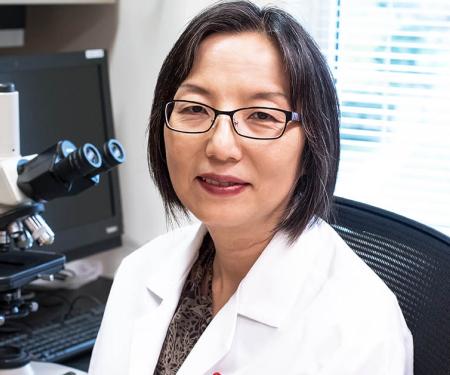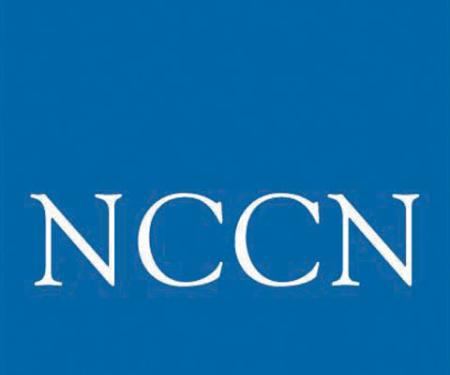Related Articles
00 / 00
When treating patients with leukemia, the best outcomes result from a multidisciplinary approach to care. At Fox Chase Cancer Center, our team of medical oncologists, radiation oncologists, radiologists, and hematopathologists work together seamlessly to diagnose your cancer and help you understand your treatment options. We value our role in helping you and your loved ones make informed decisions about your treatment.
After your diagnosis has been confirmed, your medical team will work closely with you to help you understand your condition and select a treatment plan. Treatment is based on multiple factors, including:
As a Fox Chase patient, you will be connected with a nurse navigator, who will help you see as many members of your treatment team as possible in one day. Together, your care team will create an individualized treatment plan for you.
This coordinated approach lets us offer the most thorough, supportive, and personalized care to each individual as well as provide our patients access to innovative therapies, state-of-the-art technologies, and clinical trials.
Treatment options for leukemia available at Fox Chase include:
Acute myeloid leukemia (AML) is the most common type of acute leukemia diagnosed in adults. AML patients often begin aggressive treatment soon after receiving a diagnosis, and their treatment may include chemotherapy, targeted therapy, and/or bone marrow transplantation. Participation in a clinical trial may also be recommended.
Chemotherapy drugs disrupt the life cycle of cancer cells by altering the instructions that tell them how and when to grow and divide. The two types of chemotherapy used for AML are anthracyclines (which damage the DNA in cancer cells) and anti-metabolites (which prevent the building blocks of DNA from being used by cancer cells to divide into new cells).
A common treatment for AML begins with induction chemotherapy, which involves a combination of drugs used to destroy as many leukemia cells as possible and bring blood cell counts back to normal. This is generally followed by consolidation chemotherapy, which is used to destroy any remaining leukemia cells that cannot be easily detected in the blood or bone marrow.
Targeted therapy is a type of systemic therapy that works to stop cancer cells from reproducing and growing. It is typically used to target certain gene mutations and surface proteins of cancer cells. Targeted therapy may be used alone or in combination with chemotherapy.
A bone marrow transplant, also called a stem cell transplant, infuses healthy cells into the body to replace damaged or diseased bone marrow. This procedure may be used in conjunction with chemotherapy alone or in combination with total body irradiation.
Transplant options for leukemia include autologous (using your own previously collected cells) and allogeneic (using donated cells) transplants, although allogeneic transplants are far more common for treating AML.
For an allogeneic transplant, healthy bone marrow cells come from a related or unrelated donor. During the process, the patient receives high-dose chemotherapy to destroy their cancerous cells and then has the donor cells infused into their body.
Transplantation is also a key treatment for AML that returns after previous treatment and remission (relapsed) or AML that does not respond to prior treatment (refractory).
Chronic lymphocytic leukemia (CLL) is the most common type of chronic leukemia diagnosed in adults. Because this disease is typically slow growing, many patients with CLL do not require immediate treatment.
When treatment is needed, patients may receive targeted therapy, antibody treatment, chemotherapy, or a bone marrow transplant.
Targeted therapy impedes the growth process that is specific to cancer cells. For CLL, these therapies include kinase inhibitors that restrict cell growth signals. A medication called ibrutinib, which is a Bruton’s kinase inhibitor, is considered a key first-line treatment for CLL. Other options include BCL-2 protein inhibitors, which cause cancer cells to self-destruct.
Antibodies are Y-shaped proteins that help the body detect and fight germs. In some cases, certain antibodies can be engineered in a lab to recognize certain types of cancer (including CLL).
Some of these antibodies are able attach to the surface protein of cancer cells and mark them for destruction or kill them directly. Others, called immune checkpoint inhibitors, attach to immune cells and allow the immune system to destroy the cancer cells.
Chemotherapy works by damaging cancer cells or causing them to destroy themselves. Chemotherapy is often used with antibody treatment (called chemoimmunotherapy) for CLL treatment.
An allogenic transplant (which involves the donation of healthy bone marrow cells from a related or unrelated donor) may be an option to treat CLL. In this process, patients receive high-dose chemotherapy to destroy cancerous cells and then have the donor cells infused into their body.
The hallmark feature of chronic myeloid leukemia (CML) is the presence of the Philadelphia chromosome, which contains the abnormal fusion gene BCR-ABL1. This gene makes a new protein that causes uncontrolled cell growth. Treatment for CML aims to stop the activity of that fusion protein.
CML is usually treated with targeted therapy, which focuses on specific or unique features of cancer cells. Chemotherapy or bone marrow transplant may also be considered for treating this disease.
Targeted therapies attack how cancer cells grow and divide in the body. Tyrosine kinase inhibitors (TKIs) are a standard type of targeted therapy for CML. They stop the action of molecules that help cancer cells grow and divide.
The TKI used for the patient’s CML depends on many factors, including their age, the phase and level of risk of their disease, and whether they have other health issues (such as an enlarged spleen).
Chemotherapy may be used to treat CML that is resistant to and/or intolerant of two or more TKIs.
An allogeneic bone marrow transplant is the main treatment option for advanced CML. This transplant type involves the donation of healthy bone marrow cells from a matched related or unrelated donor. The patient receives high-dose chemotherapy to destroy cancerous cells and then has the donor cells infused into their body.
Treatment for acute lymphocytic leukemia (ALL) is complex. Options include chemotherapy, antibody treatment, CAR T-cell therapy, tyrosine kinase inhibitors, corticosteroids, radiation therapy, and bone marrow transplantation.
Age, fitness level, and the type of ALL play key roles in an individual’s treatment plan.
Chemotherapy is a very common treatment for ALL. Your care team will consider which of the many standard regimens is best for you and whether chemotherapy should be combined with other treatments. Chemotherapy may also be helpful for T-cell ALL that has relapsed (returned after remission) or is refractory (becomes resistant to treatment).
When chemotherapy cannot be used, corticosteroids may be an option as a lower intensity treatment for older adults or those who are very ill.
For certain types of ALL, targeted kinase inhibitors (TKIs) may be added to chemotherapy treatment to stop the growth signals of cancer cells. A TKI may also be used during the maintenance period after chemotherapy or a bone marrow transplant.
Antibodies are proteins in the immune system that help the body fight germs. Monoclonal antibodies can be made in a lab to recognize and fight certain types of cancer. They attach to cancer cells to mark them for destruction by the immune system or destroy them directly.
An allogeneic transplant may be a treatment option depending on the type of ALL the patient has. This transplant type involves the donation of healthy bone marrow cells from a matched related or unrelated donor. The patient receives high-dose chemotherapy to destroy cancerous cells and then has the donor cells infused into their body.
CAR T-cell therapy involves removing the patient’s T-cells from their body and adding chimeric antigen receptors (CARs) to them in the lab. These receptors allow the T-cells to recognize and destroy leukemia cells when they are infused back into the patient’s body.
Other immunotherapy drugs may also be used for treating relapsed or refractory B-cell ALL.
Radiation therapy uses high-energy x-rays to treat ALL that has spread to the brain. The treatment damages the DNA in cancer cells, either killing them or stopping new growth.




